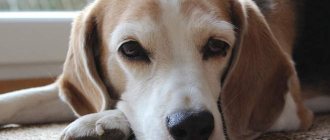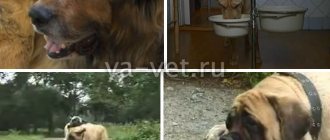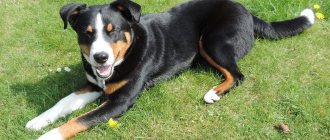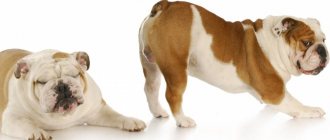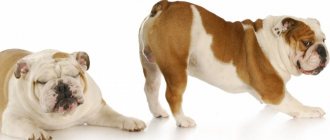Intestinal obstruction is a syndrome characterized by partial or complete disruption of the movement of contents along the digestive tract. In dogs, it can be caused by a mechanical obstruction, as well as a violation of intestinal motility.
The syndrome is diagnosed in dogs, regardless of their age and breed. However, stray animals that may eat foreign objects are at particular risk. Read on to learn more about how intestinal obstruction develops and what the animal owner needs to do.
See this article:
Causes Signs of intestinal obstruction Forms and characteristics of the disease What to do? Diagnosis of the condition Treatment of intestinal obstruction Rehabilitation after surgery Prevention of the disease Prognosis
Causes
Obesity, a sedentary lifestyle, and chronic constipation are factors that provoke the development of intestinal obstruction in dogs. They increase the severity of symptoms, and also make the clinical picture even more vivid and noticeable.
Among the main causes of intestinal obstruction in dogs:
- Poor nutrition.
Bones, hard-to-digest veins, low-quality meat, missing foods are some of the factors that can cause intestinal obstruction. This is due to the fact that solid parts of food can close the lumen of the digestive tube.
- Eating disorder.
If the pet starved for a long time (for example, did not have access to food for 2-3 days or more), and then received a large portion of food, then intussusception is possible, i.e. the introduction of one part of it into the lumen of another.
- Entry of foreign objects into the gastrointestinal tract.
By mistake, a dog may swallow inedible objects (for example, sewing supplies, rags, stones, plastic bags, parts from a toy construction set). Young pets who pick up trash on the street are at particular risk.
- Diseases caused by parasitic worms.
Helminthic infestations provoke mechanical blockage of the intestines and the inability to move products through it. The most widespread are tapeworms, as well as the nematodes Toxascaridis leonina, which parasitize the intestines.
- Various pathologies.
Among them: benign and malignant neoplasms, peristalsis disorders, diseases of the gastrointestinal tract, etc. They can lead to dynamic intestinal obstruction in dogs.
Causes of intestinal obstruction in dogs
There are several different causes of intestinal obstruction:
- Blockage of the intestine with stones, foreign bodies (bones, stones, ropes, polyethylene, synthetic padding from toys, etc.) - obstructive ileus (obturatio; lat. blockage). In small puppies with severe helminthic infestation, cases of obstruction due to intestinal blockage by helminth balls have been described. This usually happens after deworming and the death of parasites.
- Obstruction caused by rotation, strangulation, intussusception - strangulation ileus (Latin strangulatio - strangulation from the Greek στραγγ?λη - noose, gallows). This type of obstruction includes such dangerous phenomena as gastric volvulus and strangulated hernia.
- Due to intestinal embolism (blockage of blood vessels with air bubbles, fat).
Signs of intestinal obstruction
The first sign that is important to pay attention to is the absence of stool for more than 12-24 hours. There is an inability to defecate, despite the fact that the pet has a clear need to defecate (for example, he asks to go for a walk).
At the same time, the general condition of the animal worsens. The pet does not play and avoids active movements. There may be a restless and anxious state, whining, and in especially severe cases, even squealing.
The abdominal muscles are in a tense state. At the same time, the dog does not allow itself to be stroked on its stomach. Some animals show aggression, which arises in them due to strong and persistent painful sensations.
The main symptoms of intestinal obstruction in dogs:
- complete refusal of water,
- lack of appetite,
- inability to defecate,
- vomiting foam or bile,
- bloating of the abdominal area,
- increased salivation,
- blanching of the mucous membranes,
- pain when palpating,
- unnatural pose,
- general depression
- decreased body temperature (below 38 °C).
Abdominal pain can be of varying intensity: from weak (occurs only upon palpation of the damaged abdominal area) to strong (present constantly, so the pet “cannot find a place for itself” and stretches its hind limbs, trying to relieve the painful sensations).
The frequency of gagging is determined by the location of the obstruction. The closer it is to the stomach, the more often vomiting occurs. In cases where the dog has low colon obstruction, there may be no vomiting at all.
Is your pet exhibiting one or more signs? Seek professional veterinary care immediately. The faster the veterinarian takes action, the lower the likelihood of dangerous consequences and death!
Symptoms of intestinal obstruction in dogs
Symptoms of intestinal obstruction are not always pronounced and depend on the specific case and the characteristics of the animal’s body.
As a rule, the most striking symptoms occur with problems associated with the stomach and duodenum. In such cases, there is usually repeated vomiting, severe pain, and a rapid deterioration in the patient’s general condition. On the one hand, an acute illness with a severe course is bad for the patient and leads to rapid depletion of the body’s vital forces, but on the other hand, such a condition forces owners and doctors to act quickly, efficiently, and this is good, because. diagnostics do not extend over time.
In the absence of obvious symptoms of intestinal obstruction, one can usually observe lethargy of the animal, refusal to feed, and periodically vomiting, which does not seem to be the main symptom, and may not exist at all.
In such cases, X-ray examination is a very valuable diagnostic method.
Forms and characteristics of the disease
Acute intestinal obstruction (AIO). It comes suddenly and develops rapidly. Characterized by pronounced symptoms. The acute form of the disease poses a serious danger to the life and health of dogs, and therefore requires immediate seeking professional veterinary help.
Chronic intestinal obstruction (CIO). In the initial stages, it develops asymptomatically. Signs of pathology increase gradually: first there is a deterioration in appetite and only after a while - a complete refusal to eat. Most often, the chronic form of obstruction occurs as a result of diseases of the gastrointestinal tract.
How to recognize the disease
Symptoms are similar to those of poisoning:
- weakness, malaise;
- refusal of food and water;
- vomit;
- bloating;
- stomach ache.
These signs appear the very first. When walking an animal, you should pay attention to whether there was a bowel movement during the walk.
Lack of bowel movements combined with vomiting, refusal to eat and abdominal pain is the main sign of intestinal obstruction.
If you notice these symptoms, you should contact a veterinary clinic as soon as possible, establish an accurate diagnosis and begin treatment.
Without treatment, the dog's condition will worsen:
- The tone of the abdominal muscles will increase. In this case, the pet may try to stretch its hind legs, straining their tips;
- gases accumulate in the stomach, which make themselves felt by strong rumbling;
- severe belching, unpleasant odor from the mouth;
- vomiting does not stop; in some cases, feces may come out along with the vomit.
At this stage, necrosis of part of the intestine occurs, its rupture, intoxication of the body, severe dehydration, loss of salts and protein. At this stage, it is not always possible to save the dog.
It should be borne in mind that intestinal obstruction may be partial. In this case, there is a small lumen in the intestine through which gases and some feces can escape. This can be confusing for a dog owner and deter them from visiting a doctor. You need to know that partial obstruction is just as dangerous as complete obstruction.
What to do?
Without immediate medical attention, intestinal obstruction is fatal. If you suspect illness, take your pet to a veterinarian immediately.
To increase your dog's chances of recovery, you should:
- Contact a veterinary clinic immediately . Do not self-medicate or give your pet laxatives under any circumstances. This can lead to irreversible consequences for the health and life of the dog.
- The most accurate description of the animal's condition to the veterinarian . State why you decided to seek help. If you know what reasons led to the development of obstruction, also inform the specialist about them.
- Answer all questions from the veterinarian . About the kind of life the dog led, how the pet was cared for, its daily routine, and the likelihood of swallowing a foreign object. Be sure to report any past or existing illnesses.
Symptoms of laryngopharyngeal reflux
- Dysphonia or hoarseness;
- cough;
- feeling of a lump in the throat;
- discomfort and feeling of mucus in the throat;
- dysphagia (impaired swallowing).
Some researchers believe that chronic irritation of the larynx may lead to the development of carcinoma in patients who do not drink alcohol or smoke, although there is no data to support this.
Symptoms characteristic of LPR may also be caused by the following conditions:
- postnasal drip;
- allergic rhinitis;
- vasomotor rhinitis;
- upper respiratory tract infections;
- habitual coughing;
- use of tobacco or alcohol;
- excessive use of voice;
- changes in temperature or climate;
- emotional problems;
- environmental irritants;
- vagal neuropathy.
Diagnosis of the condition
If you suspect intestinal obstruction, contact your veterinarian. After a thorough visual examination and palpation, the veterinarian will conduct an x-ray examination of the abdominal cavity in two projections. This will allow you to determine where the foci of gas formation are located, the density of which is lower than the density of soft tissue.
Additionally, X-ray images show signs of inflammation affecting the serous membranes of the abdominal cavity (peritonitis). Its presence indicates the need for emergency surgical intervention.
Assigned studies:
- measuring body temperature,
- general/biochemical blood test,
- stool analysis (if possible).
If a simple study does not allow an accurate diagnosis, an x-ray with contrast is prescribed. Barium sulfate is used as a contrast agent. In appearance, it is a fine-crystalline white powder with no specific odor. It is not absorbed from the intestines and is tracked in the images by a contrasting (white) spot.
Diagnosis and treatment
For diagnosis the following is carried out:
- palpation of the abdomen to identify compactions, increased tone and pain;
- urine and blood analysis to determine the degree of intoxication of the body;
- X-ray examination;
- Ultrasound.
Some objects lodged in the intestines are not visible on x-rays. To clarify the obstruction and determine the location of the foreign object, the dog is given a contrast agent.
After this, several x-rays are taken at certain intervals. They trace the movement of the contrast agent through the esophagus, stomach and intestines. When its progress stops, it is possible to determine where the blockage has occurred in the intestine.
The doctor’s task is to determine whether the foreign object can be removed without surgical intervention. If possible, then:
- carry out intestinal lavage by introducing special preparations or herbal decoctions into it using an enema;
- a medicine is prescribed that stimulates the intestines, it is administered as an injection or dropper;
- it is necessary to administer saline solutions to restore the water-salt balance, which is disturbed due to intoxication and vomiting;
- For severe pain, painkillers will be required.
In some cases, surgery is required for diagnosis. An operation is performed to determine the cause of the blockage, the severity of intestinal damage, and possible complications in the form of ruptures.
Simultaneously with the diagnosis, the cause of the obstruction is eliminated. In case of severe tissue damage and death, part of the intestine is removed.
Regenerative therapy
If the cause of obstruction was eliminated without surgical intervention, then restorative therapy includes:
- diet;
- peace at first;
- as prescribed by the doctor - special physical exercises and therapeutic abdominal massage.
The food should consist of liquid food, it needs to be warmed up a little. The frequency of feedings is at least 5 times a day, the portions are small. The daily portion is increased gradually.
If the treatment was performed surgically, the recovery will be long. At first, the dog should be under the supervision of a doctor, anti-inflammatory and antibacterial drugs are prescribed. The animal is not fed for several days; the body is supported with saline solutions.
Treatment of intestinal obstruction
In 9 out of 10 cases, when treating intestinal obstruction in dogs, a surgical (surgical) method is used. The exception is partial obstruction (for example, blockage of the intestines with sand or solid feces), for the elimination of which it is sufficient to use enemas. In other situations, emergency surgery is prescribed.
To facilitate bowel movements, natural oils of plant origin are introduced through the oral cavity. Laxatives should only be prescribed by a veterinarian with caution.
Surgery to treat intestinal obstruction in dogs is performed under general anesthesia (anesthesia). The surgical technique is determined by the factor that provoked the development of the disease in the animal.
If no necrosis is detected on the intestinal walls and blood circulation is maintained, then the veterinarian’s task is to ensure maximum safety of the organ. If the necrotic process has already begun, then the affected area is completely removed.
How to tell if your cat has an intestinal obstruction
- The cat may vomit; if the blockage is partial, then the vomiting will be intermittent, but if the blockage is complete, then vomiting will be frequent and there will be no relief. In addition, there is projectile vomiting if the blockage occurs in the upper intestines. If the blockage occurs in the lower sections, then the vomit is brown and smells like cat feces.
- Also, if there is a partial blockage, the cat may have diarrhea. If a cat has a full-fledged blockage, then it will not be able to go to the toilet, and gases will not pass out.
- The animal may become dehydrated, the stomach will swell, and the animal will also have severe abdominal pain. The cat will lose its appetite.
Rehabilitation after surgery
After surgery, careful monitoring of the pet's condition is necessary. A fasting diet is recommended for the first 24 hours. Make sure your pet has free access to clean and fresh water. Then broth and liquid porridge are gradually introduced into the diet. The main thing is to feed your pet in small portions.
In parallel, parenteral nutrition is used. Plasma substitutes and nutritional components in the form of solutions are administered intravenously to the dog. A course of antibiotics is prescribed, which must be given to the pet at the same time to prevent the development of a surgical infection. In addition, it is necessary to monitor the progress of recovery and undergo repeated ultrasound examination.
Other features of rehabilitation after surgery:
- 14 days after the operation, it is necessary to include fermented milk products (low-fat cottage cheese, yogurt, kefir) in the diet,
- gradually you need to introduce oatmeal and buckwheat porridge, as well as boiled vegetables, with the exception of potatoes and cabbage,
- it is important to ensure complete rest for the dog, even short walks on a leash are allowed no earlier than 7-10 days after the intervention,
- the duration of walks after receiving permission from the veterinarian must be increased gradually: from 5-10 minutes or more,
- Additionally, immunomodulators and mineral-vitamin complexes are prescribed to improve the pet’s condition after the intervention.
Laryngophangeal reflux and GERD
Although stomach acid is common to both LPR and GERD, many differences exist, making LPR a distinct clinical entity.
- A prerequisite for GERD is heartburn, which is reliably observed only in 40% of patients with LPR.
- Most patients with GERD have evidence of esophagitis on biopsy, while patients with LPR have evidence of esophagitis in only 25% of cases.
- GERD is thought to be a problem of the lower esophageal sphincter and occurs primarily when lying down. In contrast, LPR is seen primarily as a problem of the upper esophageal sphincter, and occurs primarily in an upright position during exercise.
- To form LPR, much less acid exposure is required than with GERD.
There are significant differences between the mucous membrane of the esophagus and larynx.
- The upper limit of normal for acid reflux into the esophagus is considered to be up to 50 episodes per day, while 4 episodes of reflux into the larynx is no longer considered normal.
- In the larynx, unlike the esophagus, which eliminates acid through peristalsis, refluxate persists much longer, causing additional irritation.
- The epithelium of the larynx is thin and poorly adapted to combat caustic chemical damage from the same pepsin and acid.
Disease prevention
The most common cause of intestinal obstruction is improper feeding of dogs. Do not give your pet bones, food from the table, or flour products. Make sure your dog does not eat household items or garbage. Train your pet so that it takes food only from its owner and in a certain place.
Basic preventive measures:
- To avoid developing intestinal obstruction , monitor physical activity. Consult with your veterinarian which load will be most optimal for your pet, taking into account its weight and body characteristics;
- Don't forget about deworming . It should be carried out once every 3 months to prevent the development of helminthic infestations. Its implementation is mandatory, even if your pet does not go outside and does not come into contact with other animals;
- For training and playing with animals, use only special toys . Do not give your pet pebbles, sticks or foam objects under any circumstances. He may swallow them, which will cause intestinal obstruction;
- While walking, make sure that your dog does not try to swallow foreign objects. Be sure to use a leash. It is possible that even trained animals, sensing an attractive odor, swallow foreign objects.
Prevention
The dog owner should pay attention to the choice of toys for his pet - they should not be too small, and during walks, make sure that no stone or other foreign body is swallowed. Carry out deworming in a timely manner. Walking or dynamic play immediately after feeding increases the risk of volvulus.
Puppies and older animals are at particular risk of intussusception when transitioning to adult feeding. Excessively abundant feeding once a day is a risk of developing pathology. Ideally, an adult healthy animal is fed twice a day, puppies - according to their age. For older dogs, smaller, more frequent feedings are recommended.
Currently reading:
- What to do and how to help a dog or puppy with constipation
- Thyroid dysfunction in dogs (hypothyroidism)
- 13 Causes of Indigestion and Diarrhea in Dogs
- Seven Signs and Remedies for Getting Rid of Fleas in Dogs
Forecast
Without seeking professional veterinary help at a clinic, the probability of death is almost 100%. It is impossible to prescribe competent treatment at home. In addition, in most cases, emergency surgery is required.
If you contact your veterinarian immediately when the first signs appear (lack of stool, loss of appetite, decreased temperature, etc.), then the prognosis is favorable. After the operation, it is enough to follow simple recommendations to restore your pet’s health.
Remember that the dog’s condition depends on your attentiveness and care!
Symptoms of intestinal blockage
You should be alert to the following symptoms:
- oppression;
- refusal to drink and eat;
- absence of stool for more than a day;
- abdominal pain;
- bad odor from the mouth;
- vomiting with fecal matter.
The dog is vomiting
If feces are found in the vomit, the situation is threatening, indicating complete obstruction.
With partial obstruction, the pathological symptoms subside, the dog drinks and eats, but after 3-4 days the painful condition returns.
